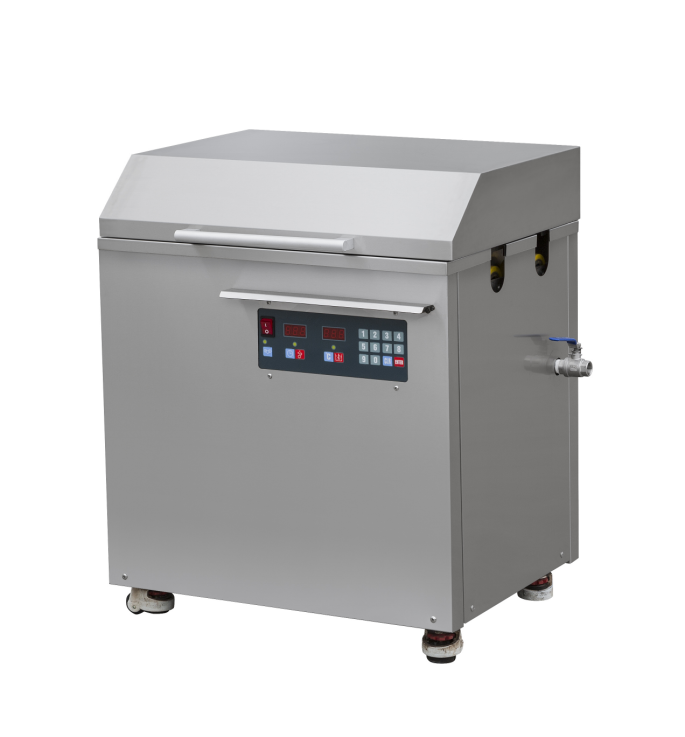1) What is ultrasound
Waves can be divided into three kinds, namely infrasound, sound wave and ultrasonic wave. Infrasound frequency is below 20Hz; The frequency of sound wave is 20Hz ~ 20kHz; Ultrasonic frequency is more than 20kHz. Infrasound and ultrasound are inaudible to the human ear. Ultrasonic because of the high frequency, short wavelength, so the propagation of good directivity, strong penetration, which is why the design of ultrasonic cleaning machine reasons.
2) How does ultrasonic cleaning work
The high-frequency oscillation signal issued by the ultrasonic generator is converted into high-frequency mechanical oscillation by the transducer and propagated to the medium - cleaning solvent, and the ultrasonic radiation in the cleaning liquid is dense and forward, so that the liquid flows and generates tens of thousands of tiny bubbles. These bubbles form and grow in the negative pressure region where the ultrasonic wave propagates longitudinally, and close quickly in the positive pressure region. In this process known as the "cavitation" effect, the closure of the bubble can form an instantaneous high pressure of more than 1000 air pressure, and continuously produce instant high pressure like a series of small "explosions" constantly impact the surface of the object, so that the surface of the object and the dirt in the gap quickly peel off, so as to achieve the purpose of surface purification of the object.
In the middle is a layer of stainless steel plate with a certain thickness, the energy exchange head is stuck under this layer of steel plate, and the AC electrical signal of a certain frequency and voltage generated by the ultrasonic source drives the energy exchange head and the stainless steel plate to do high-frequency vibration together. When the steel plate vibrates upward, the water is pushed upward, and when the steel plate vibrates downward, the water cannot keep up with the vibration speed of the steel plate. A gap will be formed between the water and the steel plate, so that repeated vibration will have many bubbles formed, as shown in the figure: this bubble is produced by the "cavitation effect", we call it the cavitation bubble. The cavitation bubble propagates to the water along the direction of vibration, and if there is a workpiece in the water, the cavitation bubble hits the surface of the workpiece to produce a collision force of thousands of atmospheres, driving the dirt off the surface of the workpiece.
Ultrasonic cleaning is the use of ultrasonic cavitation in the liquid, acceleration and direct flow effect on the liquid and dirt, so that the dirt layer is dispersed, emulsified, stripped to achieve the purpose of cleaning. At present, in the ultrasonic cleaning machine used, the cavitation action and direct flow action are applied more.
Cavitation: Cavitation is the transmission of ultrasonic waves to the liquid in a high-frequency transformation mode of compression force and pressure reduction interaction more than 20,000 times per second. When the pressure is reduced, the phenomenon of vacuum nuclear group bubbles is produced in the liquid. When the compression force is used, the vacuum nuclear group bubbles produce a strong impact force when crushed by pressure, thereby stripping the dirt on the surface of the cleaned object, so as to achieve the purpose of precise cleaning. In the ultrasonic cleaning process, the bubble that can be seen by the naked eye is not a vacuum nuclear group bubble, but an air bubble, which can inhibit the cavitation effect and reduce the cleaning efficiency. Only when the air bubbles in the liquid are completely removed, the vacuum nuclear group bubbles of cavitation can achieve the ideal effect.
● Direct flow: The phenomenon of ultrasonic flow in the liquid along the direction of sound propagation is called direct flow. When the intensity of the sound wave is 0.5 W/cm2, the direct flow can be seen by the naked eye, and the flow is perpendicular to the vibration plane, and the flow rate is about 10cm/s. Through this direct flow, the micro-oil dirt on the surface of the cleaned matter is stirred, and the cleaning liquid on the surface of the dirt is also convective, and the dissolved liquid of the dissolved dirt is mixed with the new liquid, which speeds up the dissolution rate and plays a great role in the handling of the dirt.
● Acceleration: Acceleration generated by liquid particles. For ultrasonic cleaning machines with higher frequencies, the cavitation effect is very insignificant, and the cleaning at this time mainly relies on the ultra-precision cleaning of the dirt by the acceleration of the impinging particles under the action of liquid particles.
3) The composition of ultrasonic cleaning machine: ultrasonic cleaning machine is mainly composed of two parts: ultrasonic cleaning tank and ultrasonic generator. The ultrasonic cleaning tank is made of high quality stainless steel with strong elasticity and corrosion resistance, and the ultrasonic transducer is installed at the bottom. The ultrasonic generator generates high frequency and high voltage, which is transmitted to the transducer through the cable connection line, and the transducer produces high frequency resonance with the vibration plate, so that the solvent in the cleaning tank is washed by the ultrasonic wave.

